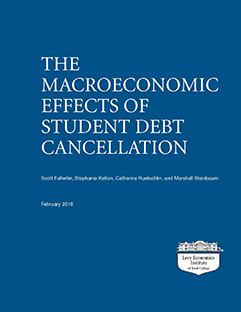
Research Topics
Publications on Government intervention
-
The Macroeconomic Effects of Student Debt Cancellation
Research Project Report, February 2018 | February 2018 Among the more ambitious policies that have been proposed to address the problem of escalating student loan debt are various forms of debt cancellation. In this report, Scott Fullwiler, Research Associate Stephanie Kelton, Catherine Ruetschlin, and Marshall Steinbaum examine the likely macroeconomic impacts of a one-time, federally funded cancellation of all outstanding student debt.
Among the more ambitious policies that have been proposed to address the problem of escalating student loan debt are various forms of debt cancellation. In this report, Scott Fullwiler, Research Associate Stephanie Kelton, Catherine Ruetschlin, and Marshall Steinbaum examine the likely macroeconomic impacts of a one-time, federally funded cancellation of all outstanding student debt.
The report analyzes households’ mounting reliance on debt to finance higher education, including the distributive implications of student debt and debt cancellation; describes the financial mechanics required to carry out the cancellation of debt held by the Department of Education (which makes up the vast majority of student loans outstanding) as well as privately owned student debt; and uses two macroeconometric models to provide a plausible range for the likely impacts of student debt cancellation on key economic variables over a 10-year horizon.
The authors find that cancellation would have a meaningful stimulus effect, characterized by greater economic activity as measured by GDP and employment, with only moderate effects on the federal budget deficit, interest rates, and inflation (while state budgets improve). These results suggest that policies like student debt cancellation can be a viable part of a needed reorientation of US higher education policy.
Download:Associated Programs:Author(s): -
The State and National Systems of Innovation
Working Paper No. 823 | December 2014A Sympathetic Critique
This paper starts with a review of the literature about National Systems of Innovation (NSI), by linking the origin of the concept to the evolutionary theory of the firm and innovation. The first point reviews the flaws of the NSI concept by looking at the pioneering works of Chris Freeman, Bent-Åke Lundvall, and Richard Nelson. These authors’ definitions of NSI contain some striking aspects: (1) the definitions are so broad that they can encompass almost everything; (2) although all definitions share the central role played by institutions, the state and its policy are not explicitly mentioned; and (3) it is not clear if the NSI concept is a descriptive or a normative tool. The second point we would like to make is that, when the role of the financial system was finally recognized by evolutionary traditions, it was just added as a “new” element within the NSI. The main aim became one of including the financial system within the NSI and looking for the “right” financial system for the “right” type of innovation. After addressing the weaknesses of the conceptualization of the state within the NSI and the difficulty of the evolutionary theory in understanding the financialization of the economy, our third and last point refers to a new way to view innovations. As Mariana Mazzuccato shows, the state has always been a fundamental, though indirect, actor for the development of certain innovations in certain sectors. Yet this is not enough, especially in a period of crisis. The state should direct innovative activities toward more basic and social needs, thus becoming an “innovator of first resort.”
Download:Associated Program:Author(s):Giovanna Vertova
